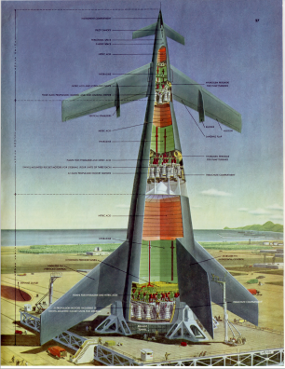 Did you ever wonder why your graying old fannish compadres are so space happy? Why science fiction from before the 90s constantly harped on trips in space, colonies throughout the solar system, missions to other stars?
Did you ever wonder why your graying old fannish compadres are so space happy? Why science fiction from before the 90s constantly harped on trips in space, colonies throughout the solar system, missions to other stars?
It may have a little something to do with the space frenzy we all grew up with – from Walt Disney’s collaboration with Werner von Braun, to Willy Ley’s popularizing articles and books and, perhaps most influential of all, Chesley Bonestell’s illustrations of what it was going to be like when we got OUT THERE!
Starting in the late 40s, (as the US and USSR began squeezing their captured NAZI rocket scientists for the secrets behind their V-2 ballistic missile program), the possibility of space flight began to become a reality. Coupled with THE POWER OF THE ATOM, it seemed that man’s horizons had suddenly become limitless. Despite continued ridicule from the man-in-the-street, more forward thinking people (fans) quickly became enamored of the possibilities – fueled by the speculations of some of the greatest science and science fiction writers of all time.
The SF magazines regularly published space technology features and columns; publishers picked up on the ‘craze’ and began producing books (like Astronauts, a punch out book) for young and old alike; television shows like Tales of Tomorrow and Science Fiction theater joined radio programs like Dimension X and major motion pictures (like Destination Moon) gave the craze a reality and immediacy that built into a boom of interest.
 Right at the beginning of that craze, Collier’s magazine (starting in 1888, it built itself a reputation for hard-hitting social reform) began running an 8 part series, gorgeously illustrated by Chesley Bonestell, an artist who brought reality, research and verisimilitude to his illustrations of space craft and other planets.
Right at the beginning of that craze, Collier’s magazine (starting in 1888, it built itself a reputation for hard-hitting social reform) began running an 8 part series, gorgeously illustrated by Chesley Bonestell, an artist who brought reality, research and verisimilitude to his illustrations of space craft and other planets.
Covering everything from a practical analysis of whether or not space flight was even possible, and drilling down into the detail of space suits, space stations and the then current state of the technology, Collier’s, through its reputation and wide circulation, is responsible for putting space on the lips of nearly everyone in the country.
It’s difficult (and expensive) to find those original 1952 to 1954 issues of Collier’s magazine, but, as is increasingly the case these days, we can turn to the internet for a solution: the American Institute of Aeronautics and Astronautics, Houston Section has gone to the trouble of reproducing those articles within the pages of its Horizon’s newsletter.
If you’re familiar with 50s-80s science fiction, you can clearly see how influential these articles and depictions were on the genre; if a story was confined to our solar system and relied on accurate portrayals of space flight and development, chances are good that it can trace its roots right back to these pieces.
Thanks AIAA Houston Section!
The following links to the Horizon open up hi-res PDFs; low-res versions are available here, with a little bit of scrolling.
Part 1 Part 2 Part 3 Part 4 Part 5 Part 6 Part 7 Part 8
And a gallery sampling the artwork in case you’re just too lazy to read the articles.


























